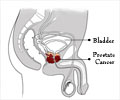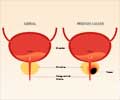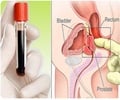Newly discovered biological markers can guide treatment for prostate cancer, reveals a new study.

‘New study discovered that genetic alterations in low-risk prostate cancer diagnosed by needle biopsy can identify men that harbor higher-risk cancer in their prostate glands. The study found that genetic alterations associated with intermediate- and high-risk prostate cancer may also be present in some cases of low-risk prostate cancers.’
Read More..




The study found the needle biopsy procedure may miss higher-risk cancer that increases the risk of disease progression. Researchers say that men diagnosed with low-risk cancer may benefit from additional testing for these chromosomal alterations.Read More..
"We have discovered new molecular markers that can help guide men in their decisions about the course of their prostate cancer care," says George Vasmatzis, Ph.D., co-director of the Center for Individualized Medicine Biomarker Discovery Program and lead author on the study.
"Overtreatment has been issue for the group of men that our study targets. We found that the presence of genetic alterations in low-risk cancer can help men decide whether treatment or active surveillance is right for them."
Prostate cancer is assessed by Gleason patterns and score that indicate grade. The Gleason patterns are strongly associated with risk of disease progression. Gleason pattern 3 prostate cancer is considered to be low-risk. Gleason patterns 4 and 5 cancer carry a higher risk of aggressive behavior.
Men whose tumor is composed entirely of Gleason pattern 3 may choose active surveillance. They are monitored closely with blood tests and needle biopsies, as necessary. Or they may be referred to treatment, such as surgery and radiation, particularly if they have Gleason pattern 4 or 5.
Advertisement
The Research
Advertisement
"The needle biopsy procedure samples only a small portion of the tumor. It is not uncommon that a man with a Gleason pattern 3 on needle biopsy specimen harbors a higher-grade cancer next to the pattern 3 that was missed by the procedure," says John Cheville, M.D., co-director of the Center for Individualized Medicine Biomarker Discovery Program and co-author of the study. "Therefore, if we identify these alterations in a Gleason pattern 3, there is a higher likelihood that Gleason pattern 4 is nearby."
Researchers took the genetic information generated using mate pair sequencing and converted it into a test called "fluorescence in situ hybridization" (FISH) that validated the genetic alterations in clinical samples. The FISH test is available for Mayo patients.
Source-Eurekalert






![Prostate Specific Antigen [PSA] Prostate Specific Antigen [PSA]](https://www.medindia.net/images/common/patientinfo/120_100/prostate-specific-antigen.jpg)




